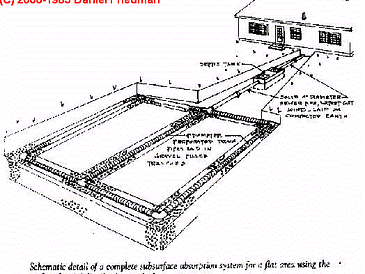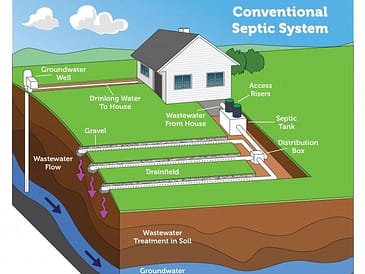Depending on where you are in North Carolina, you can install several types of septic systems in your home. These systems include Gravelless, Gravel/stone drainfield, and Chamber.
Gravel/stone drain field septic system
The gravel/stone drainfield septic system has traditionally been used in North Carolina. This system consists of a septic tank, a drain field, and a pump tank. The tank is underground, while the drain field is gravel or stone.
The gravel/stone system is suitable for tiny homes and small businesses. However, it can be unsuitable for large residential properties. The system requires an enormous footprint, and it’s best suited for areas with high groundwater tables.
If you’re considering installing a septic system, you’ll want to know the available options. While the conventional gravity system is the simplest and least expensive, it may not be appropriate for all residential sites.
A gravel-less trench design is a more advanced alternative to the conventional gravel/stone system. This system uses alternative materials, including porous concrete blocks and large-diameter pipes. It can reduce the size of the drain line by as much as 25%.
Gravelless trench designs can also be used in conventional gravity systems. However, the Environmental Protection Agency does not endorse land area reduction for these systems.
Chamber septic system
Choosing the right septic system is essential to a home’s health. Septic systems can range from conventional to eco-friendly constructed wetland septic systems. Before installing a septic system, you will need a permit from the local health department.
The location of a septic tank should be marked. It should be at least five feet away from the building’s foundation and not covered with concrete or asphalt. You should also remove trees that like wet conditions and keep the area free of construction and soil disturbance activities.
A chamber septic system is one of the most popular septic systems in North Carolina. This type of system is similar to a conventional system but is designed to store more wastewater. It is a good choice for homes with high groundwater tables.
A chamber septic system is much easier to install than a conventional system. Instead of gravel, the system is constructed with plastic chambers that hold soil. These chambers have a small carbon footprint, and they can be sized to fit smaller pits.

Gravelless septic system
Compared to gravel-lined drainfields, gravelless drainfields require less maintenance and space, but it is hard to say if they are as effective as their gravel-lined counterparts. However, they offer several benefits, including significant cost savings regarding carbon footprint.
The design of a graveled drain field uses fabric-wrapped pipes and geotextile fabric to distribute the wastewater. Some gravelless systems use recycled materials, such as rubber tires chopped into pieces suitable for the job. The fabric can support the pipes and drainfield trenches and store effluent.
The same fabric can be wrapped around a smaller-diameter pipe, which can be installed in a narrow trench. However, this may require the use of a specialized machine.
Another feature of a gravelless system is that the material can be lightweight, making it easier to install and handle. This can help reduce the cost of labor and fuel.
Some gravelless systems use alternative materials, such as porous concrete blocks or wrapped corrugated pipes. These materials can store effluent, distribute it, and help prevent blockages. They can also be lighter-weight, meaning less equipment is needed to construct the system, reducing fuel and labor costs.
Drip distribution system
Using a drip distribution system for septic systems in North Carolina allows you to disperse your wastewater more efficiently and evenly. You’ll also be able to get more treatment for your wastewater before it’s discharged into the soil. Dip septic systems are easier to install and maintain than other treatment methods.
A drip distribution system usually comprises a septic tank and small pipes. The tank collects and treats wastewater, which is then sent to a dosing chamber. The Chamber sends the treated wastewater to a pumping chamber, which moves the effluent to the distribution pipes under pressure.
The tubing in a drip distribution system is made of drip tubing, which is typically 12 inches in diameter. It is pressured at a minimum of 15 pounds per square inch. Typical dripline installations are spaced two feet apart. A designer-specified cleanout is installed at the end of each line.
Drip distribution systems can be designed to run on a straight or lateral line. When installed on a sloped site, the drip line can be run parallel to the contours. In addition, dripline installations can be laid out on two-foot centers. This can be advantageous if you need to accommodate an irregularly shaped site.





